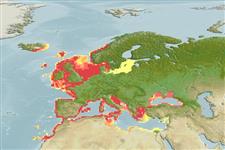Environment: milieu / climate zone / depth range / distribution range
Ecologia
marinhas demersal; intervalo de profundidade 1 - 150 m (Ref. 6790), usually 1 - 30 m (Ref. 35388). Temperate; 66°N - 27°N, 19°W - 42°E
Eastern Atlantic: Norway to Morocco, Madeira and Canary Islands, including the Mediterranean and the Black Sea (Ref. 6790). Reported from Mauritania (Ref. 55783).
Comprimento de primeira maturação / Tamanho / Peso / Idade
Maturity: Lm 12.0 range ? - ? cm
Max length : 53.0 cm TL macho/indeterminado; (Ref. 40637); common length : 25.0 cm SL macho/indeterminado; (Ref. 3397); peso máx. publicado: 1.9 kg (Ref. 40637)
Body elongate, length more than 6 times height. Greenish in upper parts, yellowish-white oblique stripes. Small 2-3 spines in front of each eye (Ref. 35388).
On sandy, muddy or gravelly bottoms, from a few meters to about 150 m. Rest on the bottom, often buried with eyes and tip of first dorsal fin exposed (Ref. 9988). At night they swim around freely, even pelagically (Ref. 35388). Feed on small invertebrates and fishes; chiefly nocturnal. Oviparous, eggs and larval stages pelagic (Ref. 4675). There are dark markings along the scales; the anterior dorsal fin is black and contains venomous spines. Utilized fresh and frozen; can be pan-fried, broiled, boiled and baked (Ref. 9988). Spawning takes place in June and August, pelagic eggs are 1 mm (Ref. 35388). Also Ref. 57406.
Ciclo de vida ou comportamento de acasalamento
Maturities | Reprodução | Spawnings | Egg(s) | Fecundities | Larvas
Oviparous, eggs and larvae are pelagic (Ref. 4675).
Roux, C., 1990. Trachinidae. p. 893-895. In J.C. Quero, J.C. Hureau, C. Karrer, A. Post and L. Saldanha (eds.) Check-list of the fishes of the eastern tropical Atlantic (CLOFETA). JNICT, Lisbon; SEI, Paris; and UNESCO, Paris. Vol. 2. (Ref. 6790)
Status na Lista Vermelha da UICN (Ref. 130435)
Uso pelos humanos
Pescarias: pouco comercial; peixe esportivo: sim; Aquário: Aquários públicos
Ferramentas
Relatórios especiais
Baixar XML
Fontes da internet
Estimates based on models
Preferred temperature (Ref.
123201): 8.7 - 18.7, mean 10.9 °C (based on 780 cells).
Índice de diversidade filogenética (Ref.
82804): PD
50 = 0.5059 [Uniqueness, from 0.5 = low to 2.0 = high].
Bayesian length-weight: a=0.00562 (0.00458 - 0.00691), b=3.05 (2.99 - 3.11), in cm total length, based on LWR estimates for this species (Ref.
93245).
Nível Trófico (Ref.
69278): 4.2 ±0.71 se; based on food items.
Resiliência (Ref.
120179): médio(a), tempo mínimo de duplicação da população 1,4 - 4,4 anos (Assuming tm=2-4).
Fishing Vulnerability (Ref.
59153): Moderate to high vulnerability (52 of 100).
Climate Vulnerability (Ref.
125649): Moderate vulnerability (38 of 100).
Nutrients (Ref.
124155): Calcium = 29.9 [20.3, 57.9] mg/100g; Iron = 0.36 [0.23, 0.58] mg/100g; Protein = 18.7 [17.9, 19.4] %; Omega3 = 0.643 [0.399, 1.025] g/100g; Selenium = 13.2 [7.3, 25.9] μg/100g; VitaminA = 23.8 [7.7, 74.1] μg/100g; Zinc = 0.445 [0.328, 0.607] mg/100g (wet weight); based on
nutrient studies.
